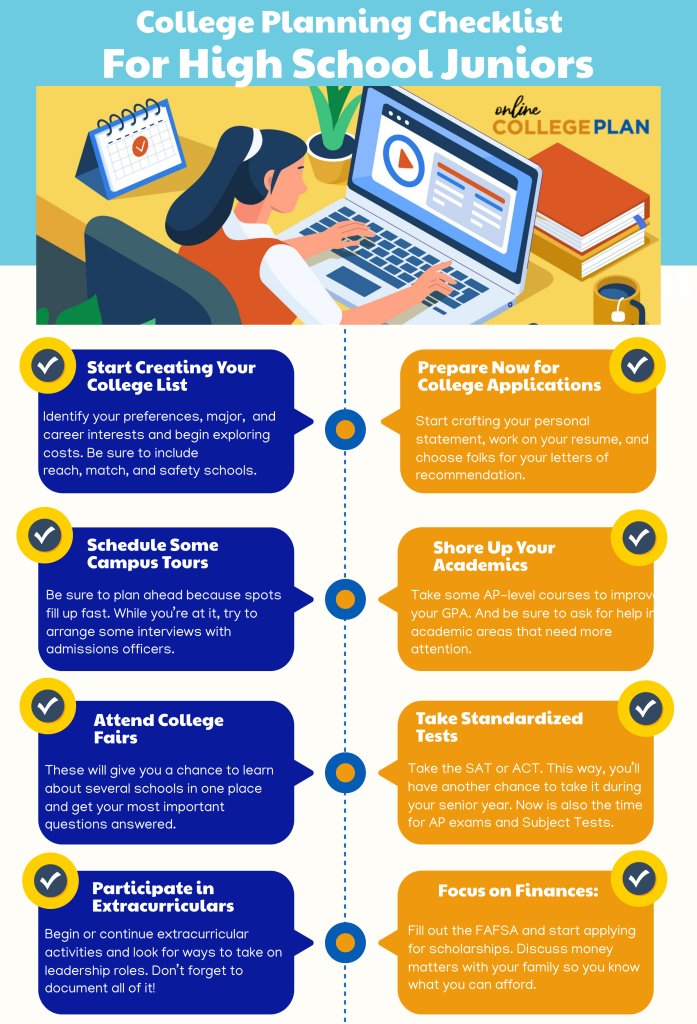Junior Year in High School: Your Go-to College Planning Roadmap
Find your degree

It’s your junior year of high school. This is the crossroads where future paths start taking shape—where college planning kicks into high gear. If you’re thinking about your future and what you need to do to get ready for college, we’re here to help. Think of this post as your personal map to help guide you through the maze of college planning in your junior year of high school.

Related Resource: Senior Year College Prep: An Easy Guide to Success
First Things First: Crafting Your College List
If you haven’t already, it’s time to create a college list. You want to identify reach, match, and safety schools. What does that mean? Think of it like aiming for a trio of baskets – “reach” schools are like shooting a three-pointer. They aren’t impossible, but they will need some serious game. Then there are the “match” schools, where you can lay up comfortably because they fit your stats pretty well. Lastly, you have “safety” schools; these are your free throws, where getting in is almost a sure shot.
Identify Your College Preferences
When you picture yourself going to college, what does it look like? Do you envision a big city campus with lots of bustle and activity? Or do you see yourself at a small college surrounded by nature? Location, size, and environment all come into play. Even if you plan to attend college online, you’ll still want to consider factors like campus culture, student services, and the overall vibe. Check out each college’s website, social media pages, and student reviews to get a better feel for things.
Consider Your Major and Career Interests
Another high-priority factor to consider when putting your college list together is your major. You’ll want to look for schools with programs that closely match your career goals and interests. Scope the curriculum and content of each program. For example, some schools offer internships and study-abroad programs. If hands-on learning is your vibe, such perks might interest you.
Start Exploring Costs
You wouldn’t buy something without checking its price tag first, would you? The same goes for picking colleges. Luckily, most have net price calculators online that predict roughly how much each will cost after factoring in potential aid packages. You can check these out before you even apply. We’ll talk more about money later on.
Key Takeaway: When you’re whipping up your list of colleges, mix in some dream schools, ones that feel just right, and some easy-peasy options. Also, consider the location, environment, and overall culture of the schools you’re eyeing. Finally, be sure they offer programs that match with what you’re into, and figure out how much cash you’ll need to shell out. That way, your college search is gonna be on point.
Diving Into Campus Visits
Visiting college campuses is something you can do at any point in your high school journey. But if you haven’t done it by Junior Year, it’s time to get a move on. Spending time on campus will give you the inside scoop on where you might be spending the next few years! Here are some tips for planning college visits:
Schedule Campus Tours
Most schools offer campus tours that can be scheduled online or by phone. You’ll want to schedule them early because spots fill up fast during busy times. Pick a date and time that works best for you (and your parents). And if you’re considering several colleges in one area, why not pack them into one epic day?
Interview with Admissions Officers
Some colleges will let you interview with an admissions officer during your visit. This is a great way to demonstrate your interest in the school and learn more about the admissions process. You’ll want to prepare for the interview by researching the school beforehand. And don’t forget to dress for success and arrive on time!
Attend College Fairs
College fairs are another great way to learn about potential choices. They’re kind of like buffets but for schools – lots of options all in one spot. You’ll find reps from various colleges with insider information about admissions requirements, campus life, and degree programs. So be sure to come prepared with a list of questions and a notebook. It’s also a good idea to bring copies of their high school transcript and test scores to share with admissions representatives.
Staying Organized and Meeting Deadlines
Juggling lots of stuff can be tough, so it’s key for students to manage their time well. This means carving out specific time for college planning, like checking out colleges, prepping for tests, and getting those applications done. It’s also helpful to figure out what’s most important and break it down into smaller steps to stop you from feeling swamped.
Understand Early Action vs. Early Decision
You may also want to consider applying early decision or early action if the college offers these options. Early decision means you’re committed to going to that college if you get in. Early action is more flexible and lets you hear back from the college sooner, so you know where you stand.
Keep Track of College Admission Timelines
Knowing the deadlines for the colleges you’re interested in is crucial. This means keeping track of when applications are due, when you’ll find out if you got in, and when you need to sort out financial aid.
Helpful Tip: The easiest way to stay on top of college application deadlines is to make a calendar or spreadsheet with all the deadlines for the colleges you like. You can also use online tools and apps to help you stay organized and make sure you don’t miss any important dates. And don’t forget to set up reminders on your phone or computer to keep you in the loop about upcoming deadlines.
Extracurricular Involvement and Leadership
High school junior year is a fabulous time to explore your passions outside the classroom. Extracurricular activities are a great way to do this. Pick things you enjoy and that line up with your interests. It could be joining a club, getting in on a sport, or volunteering. Volunteering in high school provides you with valuable opportunities to develop important skills and gain real-world experience. Just make sure it’s something that really matters to you and that you can stick with for a while.
Look for Leadership Opportunities
Getting involved in extracurricular activities can help you build up your leadership skills, too. Look for chances to step up and take on leadership roles in the stuff you’re into. Whether it’s being a club officer, team captain, or volunteer coordinator, honing those leadership skills can make you stand out when it comes to college (and scholarship) applications.
Document Achievements and Awards
If you get involved in extracurricular activities, keeping track of your wins and triumphs along the way is key. That means jotting down your volunteer hours, keeping tabs on how your team is doing, and noting down any leadership gigs you take on. This info can come in handy when you’re filling out college applications and putting together your resume to show off what you’ve achieved and how dedicated you are to your activities.
Preparing for College Applications
Junior year of high school is a big deal when it comes to getting ready for college applications. Here are some tips to help you get going:
Craft a Personal Statement
Your personal statement is a significant part of your college application. Start brainstorming ideas and writing drafts during junior year. It should show off your personality, interests, and goals, and be well-written and interesting. Get a teacher or counselor to give it a once-over to make sure it’s top-notch.
Gather Letters of Recommendation
Most colleges want letters of recommendation from teachers or other adults who know you well. Start thinking about who you want to ask during junior year. Pick someone who knows you inside out and can talk about your strengths and achievements.
Create a Resume or Activity List
College apps often need a list of your extracurricular activities, volunteer work, and other wins. Start putting this together during junior year. Include all the important stuff and give the deets about each one. You might also want to put together a resume to show off your achievements in a professional and organized way.
Academic Planning for Juniors
Junior year is imperative for planning your academic courses. That’s because it’s the last full year of academics that colleges will see when they review your application.
Select Your Courses
You may want to consider taking some challenging classes this year. Pick those that match up with what you’re into and what you want to do in the future. It’s a good idea to chat with your guidance counselor to ensure you’re on track to graduate and are taking the right college courses.
Manage Your GPA
Maintaining a solid GPA is vital for getting into college and snagging scholarships. So, be sure to put forth your best effort to get good grades. It’s also a good idea to take AP courses or dual enrollment classes to push yourself academically. This can help bump up your GPA and demonstrate you’re ready for college-level work.
Use Tutoring and Support Resources
If you’re having a tough time with your schoolwork, looking for extra help is a good idea. Most high schools have tutoring programs, study groups, and academic counseling to give students a hand. You can also reach out to your teachers and friends or check out online resources like Khan Academy or Quizlet.
Testing and Assessment
Getting tests out of the way is an excellent way to prepare for college. Plus, knowing you’ve passed with flying colors is a sure way to take the stress out of senior year.
Take the SAT/ACT
Junior year is a pretty important time when it comes to college entrance exams. The SAT and ACT are the most common, and most colleges need them. It’s a good idea to take these exams in the spring of your junior year and then again in the fall of your senior year. You can use online practice tests, test prep books, and tutoring to prepare.
Take AP Exams and Subject Tests
AP courses are like college-level classes you can take in high school. After each course, you can choose to take an AP exam. If you do well, you might get college credit and show off your skills to colleges and universities.
Some colleges and universities might ask for or suggest Subject Tests that cover topics like math, science, literature, and foreign languages. Junior year is an excellent time to start figuring out which Subject Tests you might need to take.
Note: Not all schools need AP exams or subject tests, so it’s a good idea to check out the policies of the schools you’re eyeing.
Financial Planning for College as a High School Junior
Financial planning is one of the most critical parts of getting ready for college, so don’t skip over this section.
Apply for Financial Aid
The first stop on your money-smart journey is getting cozy with the Free Application for Federal Student Aid (FAFSA). It’s available online and should be done as soon as possible after January 1st of your junior year. This form is like the golden ticket of student aid—it opens doors to grants, loans, and work-study funds from Uncle Sam. Grants are free money that does not need to be repaid, while loans must be repaid with interest. Work-study programs allow students to work part-time on campus to earn money for college.
Moving right along—there’s another player in town called the CSS Profile by College Board. Think of this one like an audition tape you send colleges showing them what kind of financial support could help you shine on campus. While not every school asks for it, those who do are often ready to hand out scholarships or grants based on what they see. So don’t be shy—submit that CSS Profile.
Apply Scholarships and Grants
Scholarships and grants are another way to cover college costs. Scholarships are often given for academic achievements, while grants are based on financial need. Some of this assistance is available through the college itself. But local businesses, non-profits, and even your high school might have opportunities for you to snag some extra cash for college. So keep an eye out in your community, and don’t be shy about asking around.
It’s worth mentioning that some scholarships and grants might have specific requirements, like being part of a particular ethnic group or studying a specific major. You might be surprised to learn that you can apply to many scholarships beginning your junior year. Be sure to read through the eligibility requirements before applying.
Save for College
Putting money aside for college is another big part of getting your finances in order. Students and their families can kick off their college savings by opening a 529 college savings plan as early as they can. This plan gives them some tax benefits and can be used to cover college expenses. Parents and students can also check out other savings choices, like a Coverdell Education Savings Account or a custodial account. It’s critical to start saving early.
Helpful Tip: Finessing Your Family Talks: Discussing money matters around dinner might seem less fun than watching paint dry, but think again. Sitting down with your family members gives everyone a chance to weigh in and figure things out together. Which schools give us bang for our buck? How much should we borrow? These chats are essential—not just fluff—and knowing everyone’s thoughts upfront will save headaches later.
Frequently Asked Questions
Junior year is a crucial time for college prep. You’ll want to create a list of colleges you’re interested in and start visiting them. You’ll also want to beef up your extracurricular involvement and stay committed to good grades. Taking the SAT or ACT is wise since you can repeat it as a senior if you aren’t happy with the results. Finally, this is the year to fill out the FAFSA and start applying for scholarships.
Junior year is the most crucial if you plan to attend college after graduation. That’s because it’s the last year schools will see a full year of your academic performance and extracurricular activities.
It’s not common for students to apply to college as juniors. Most usually apply during their senior year. When figuring out your college application timeline, it’s a good idea to chat with your high school guidance counselor. They can help you know when to apply and ensure you meet all the requirements and deadlines.
The ideal time for you to start the college application process is the summer before your senior year. In most cases, you can start submitting applications on August 1st. However, timelines can vary.
Absolutely! There are scholarships out there specifically for juniors, not just for seniors. It’s a smart move to start looking into scholarships early to up your chances of getting financial help for college. Plus, getting a jump on the search can help ease some of the stress during senior year when you’ve got a ton of things on your plate.









